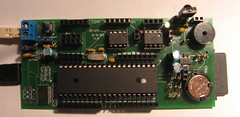 I'm far enough along that I can be posting about this thing.
I'm far enough along that I can be posting about this thing.To the left is a PCB board I designed to be the platform for the "Nex10" - the next level of the "X10 Book".
The goal is to create an X10 controller that is user configurable without the need to change the software. The Nex10 is configured through text files copied to it's SD card. More on the functionality later. This post is about the hardware!
A larger picture of the board is here.
In order to support reads and writes of the SD card, I went with a larger microcontroller - the ATmega644P. This has twice the program space of the ATmega328 used in the X10 Book. The board also has an external EEPROM, RTC (real time clock), piezo, and IR detector. It also has a difficult to solder FTDI chip that allows it to be programmed via USB. I see this as totally optional. I just wanted one to make my development easier. Besides, it's pretty cool!
Other little goodies include a resettable fuse, ISP header, and jumpers for power, auto-reset, and ARef. It runs on regulated 5V and has a voltage regulator that supplies 3.3V for the SD card. It uses a 16MHz crystal or resonator.
I used CadSoft's Eagle to create the schematic and lay out the board and BatchPCB to fabricate it. This is Rev. 1, and amazingly everything worked. If I decide to make a Rev. 2 there are a few changes I'd make, but basically I'm pretty happy. (Eagle files here.)
This board will drive an 8x32 LED Matrix from Sure Electronics. This display is very easy to read, cheap, and uses SPI so no additional hardware is needed on the board.
There is nothing about the board that is dedicated to Nex10 application - it can be used for just about any microcontroller project.
If you'd like a board very similar to this one (with a serial interface), a fellow maker, Florin, sells an easy to solder kit. You can read about it here.
I am so much on your recent development! great job! I'm currently working on sth. simillar. I want to built a controller and receiver/s working on power lines. Most of the projects so far, used dedicated controller, i want to make my own one. I will be probably using arduino mega device (+ethernet shield) as a controller (sending signals over the power lines) and smaller say avr 328 to work as receiver. I've red a nice article from microchip (Home automation controller on PIC16F877A), I'm pretty much in to it to do sth. simillar on avr. I wish you all the best. can't wait more news. If you're up for some co-operation, do not hesitate to contact me by email. lubosmichal at gmail com. Regards, Michal
ReplyDeleteMichael,
ReplyDeleteI think I'm familiar with the Microchip app note you refer to - AN236? The most interesting part for me is rolling your own powerline interface - replacing the PSC05. Is this part of your plans?
In my system, I only need 1 PSC05 at the controller and use standard X10 modules for the receiver. So other than gaining independence and interest, it would cost me more to build my own "PSC05". However I can see the benefit in making your own - especially if you need 220V modules.
Software-wise you should be able to make any controller you need using the Arduino and the existing libraries. Good luck with yours. A network interface will be nice.